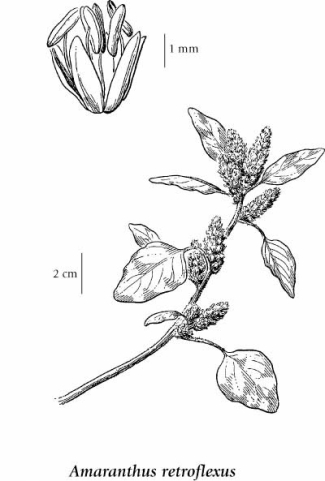The redroot amaranth can be easily mistaken for other pigweeds, mostly for the Powell’s amaranth (
Amaranthus powellii), which it resembles with its spikelike, elongated inflorescence. What separates them is mostly the conspicuous hairiness of the stems and leaves of the redroot amaranth, as opposed to the scarcely (if at all) hairy Powell’s amaranth. When young or under poor growing conditions, the redroot amaranth might resemble the other two introduced pigweeds, the mat amaranth (
Amaranthus blitoides) and white pigweed (
Amaranthus albus). In these species, though, the leaves are much smaller and the inflorescences develop in small clusters in the axils of the leaves.
Some of the members of the Goosefoot (Chenopodiaceae) family might be mistaken from a distance for the redroot amaranth, such as lamb’s quarters (Chenopodium album) or French spinach (Atriplex hortensis). However, these plants have smoother and thinner leaves, mostly wavy, all being hairless and powdery. Their inflorescences are not prickly, as in the redroot amaranth, but rather fleshy in the lamb’s quarters or sandwiched between a pair of leafy bracts in the French spinach.
The redroot amaranth might occasionally be mistaken for the red-listed wedgescale saltbush (Atriplex truncata), which can grow in similar habitat conditions, in dry roadsides and waste places. It has wedged and greenish inflorescences, but they develop in the axils of the leaves. This species can be easily differentiated based on the grayish, not grass-green leaves. The whole plant is mealy coated and much more slender than the redroot amaranth.
Note Author Anna-Mária Csergo, February 2011.
